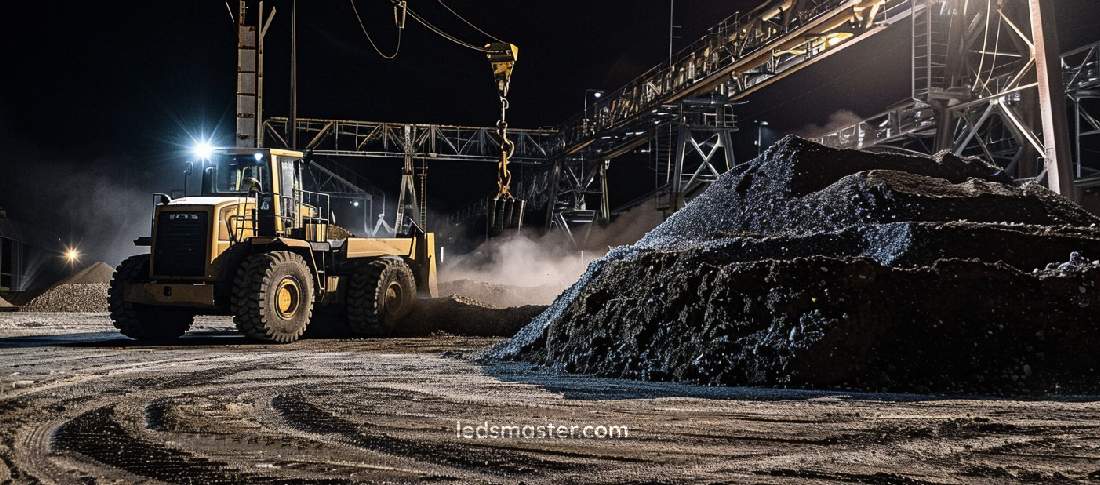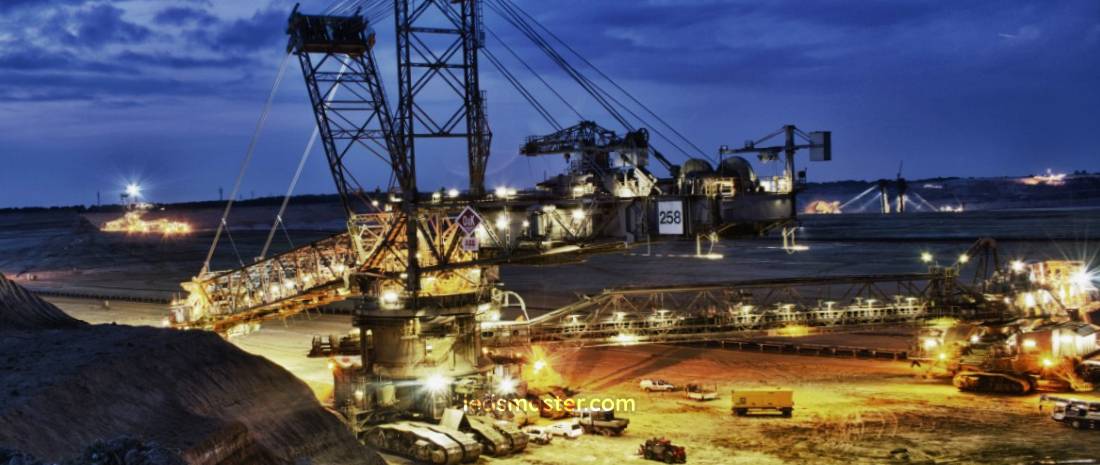Illuminate your mining operations with advanced LED technology and explosion-proof fixtures. Enhance safety, efficiency, and durability underground while reducing costs and boosting productivity.
Mining operations present unique challenges when it comes to lighting. The harsh, often hazardous environment of underground mines demands lighting solutions that prioritize safety, efficiency, and durability. This article explores the critical aspects of mining lighting, from explosion-proof requirements to the advantages of LED technology.
Get your complimentary lighting design today
Table of Contents
ToggleUnderground mining environments are inherently dangerous, and proper lighting is a factor in maintaining safety. These settings typically lack natural light and are filled with numerous obstacles and hazards, such as uneven terrain, heavy machinery, and confined spaces. In such conditions, visibility becomes a crucial aspect of safety. Adequate lighting allows workers to clearly see their surroundings, identify potential dangers, and navigate safely.

Poor lighting can lead to accidents and injuries. Workers might fail to notice a dangerous piece of equipment or an uneven surface, resulting in tripping, falling, or other accidents. Therefore, ensuring that the entire underground space is well-lit is a fundamental part of mine safety protocols. Proper illumination helps to reduce the risks associated with these potential hazards by providing a clear line of sight and enabling miners to be more aware of their surroundings.
Beyond simply lighting up a space, the quality of the lighting itself also matters. Good lighting should not produce excessive glare, as this can lead to eye strain and temporarily impair a worker’s vision, which in turn can cause accidents. Lighting systems that offer a uniform brightness across a workspace help to prevent dark spots and ensure that miners can perform their tasks effectively without unnecessary strain.
The design and implementation of lighting systems in mining must take into account the specific hazards of the environment. In underground mines, heavy dust, moisture, and extreme temperatures are common. These conditions can degrade lighting fixtures over time, leading to failures that compromise safety. For this reason, lighting systems must be built to withstand these harsh environmental factors. Explosion-proof lighting fixtures, for instance, are designed to be sealed, which prevents dust and moisture from entering and causing damage or malfunction.
Additionally, mining environments are prone to vibrations from machinery and equipment, which can also impact the durability of lighting fixtures. Lights in these settings must be vibration-resistant to prevent frequent failures. In a situation where lighting fails unexpectedly, miners may be left in complete darkness, which can increase the risk of accidents, particularly if they are operating heavy machinery or working near hazardous materials. Thus, robust lighting systems that can endure the demands of the mining environment are essential.
In addition to improving safety, effective lighting can have a positive impact on worker performance. When miners are working in well-lit conditions, they are more able to focus on the task at hand without the distraction or difficulty of poor visibility. This improves precision in tasks that require a high level of attention to detail, such as operating machinery or handling sensitive equipment.
Better visibility also helps miners move more quickly and efficiently through their tasks, as they can easily spot any obstacles or issues that may arise. This enhanced workflow contributes to the overall productivity of the mining operation, as workers can complete their tasks more efficiently and with fewer errors. Furthermore, lighting systems that reduce glare and provide comfortable levels of brightness help to minimize eye strain and fatigue, allowing workers to maintain focus for longer periods and thus enhancing overall operational effectiveness.
In recent years, LED (Light Emitting Diode) lighting has gained popularity in mining operations due to its energy efficiency and long lifespan. Unlike traditional lighting technologies such as incandescent and fluorescent bulbs, LEDs convert a higher percentage of electrical energy into visible light, making them far more efficient. This efficiency directly translates into lower energy consumption, which is especially beneficial in mining operations where lighting must often be used continuously for long periods of time.
By reducing energy usage, mining companies can significantly cut operational costs, particularly in terms of electricity consumption. This reduction in energy costs is not only financially advantageous but also helps to reduce the environmental impact of mining activities. With global attention increasingly focused on reducing carbon footprints and promoting sustainability, the adoption of energy-efficient technologies like LED lighting aligns with broader environmental goals.
LED lighting also lasts considerably longer than traditional bulbs. This extended lifespan means that mining operations can reduce the frequency of lighting replacements, which in turn lowers maintenance costs. The reduced need for maintenance is particularly beneficial in mining environments, where access to lighting fixtures can be difficult and time-consuming. Every time a fixture needs to be replaced, operations may need to pause, leading to downtime and potential loss of productivity. With longer-lasting LED fixtures, these disruptions can be minimized, allowing for more continuous and efficient operations.
In addition to the economic advantages, LED lighting offers substantial environmental benefits. One of the most significant advantages of LEDs is their ability to lower greenhouse gas emissions by consuming less electricity. This reduction in emissions helps mining companies contribute to global efforts to combat climate change and reduce their environmental impact.
Moreover, LED lights do not contain hazardous materials such as mercury, which is commonly found in fluorescent bulbs. This makes LEDs safer for both miners and the environment. The disposal of lighting fixtures that contain hazardous materials poses significant environmental risks, as improper disposal can lead to contamination of soil and water sources. By using LED lighting, mining companies can avoid these risks and ensure a safer, more environmentally friendly disposal process.
The environmental benefits of LED lighting also extend to reducing energy demand. Mining operations often require a significant amount of power, and by switching to energy-efficient lighting systems, the overall demand for electricity can be reduced. This not only helps to lower operational costs but also contributes to reducing the strain on energy resources, further promoting sustainability in mining operations.
Effective lighting design in mining is about more than just choosing the right type of fixture. It involves careful planning to ensure that lighting is distributed evenly throughout the workspace. In underground mining environments, shadows and dark spots can obscure hazards, making it difficult for workers to identify risks. By strategically placing lights in key areas, such as around heavy machinery, at workstations, and along pathways, these dark spots can be minimized, improving overall safety.
The placement of lighting fixtures should also take into account the layout and size of the mining operation. Larger spaces may require more fixtures or higher-intensity lighting to provide adequate coverage. In addition, the positioning of lights must be optimized to avoid excessive glare, which can impair workers’ vision. Adjustable mounting options and fixture angles can help to direct light where it is needed most, ensuring that workers have a clear view of their surroundings without being overwhelmed by brightness.
The construction of lighting fixtures in mining environments must be tailored to withstand the harsh conditions present underground. Dust, moisture, vibrations, and high temperatures are all factors that can degrade traditional lighting fixtures over time. For this reason, mining lighting systems are often designed to be dustproof, waterproof, and vibration-resistant.
Explosion-proof lighting fixtures, for example, are specifically engineered to prevent any sparks or heat generated by the fixture from escaping and igniting flammable gases or dust in the surrounding atmosphere. These fixtures are typically sealed with robust materials that can withstand high levels of pressure and force, ensuring that they remain operational even in the event of an explosion. This level of durability is critical in maintaining both safety and operational efficiency in mining environments.
Metals that are resistant to corrosion and wear, such as stainless steel or aluminum, are often used in mining lighting systems. These materials ensure that the fixtures remain functional over time, even when exposed to the harsh elements common in underground environments.

Lighting plays a vital role in ensuring the safety, efficiency, and sustainability of mining operations. Explosion-proof lighting fixtures are fundamental in preventing the ignition of flammable gases and dust, while the adoption of LED lighting has brought about significant improvements in energy efficiency, operational costs, and environmental impact. As the mining industry continues to embrace new technologies, lighting systems will evolve to provide even greater levels of safety and performance. With ongoing innovations in smart lighting systems, mining operations are becoming more efficient, responsive, and environmentally conscious. Through careful design and technological advancements, modern lighting solutions are helping to address the unique challenges of mining environments, creating a safer and more productive working environment for miners.
The continued evolution of mining lighting solutions is indicative of the industry’s commitment to enhancing safety and operational effectiveness. By prioritizing explosion-proof designs, leveraging the advantages of LED technology, and embracing innovative approaches to lighting management, mining companies can significantly improve working conditions for their employees. The adoption of these technologies not only fosters a culture of safety but also contributes to the overall sustainability of mining operations, ensuring that the industry can continue to meet the demands of the future while protecting the well-being of its workforce.
Ultimately, the success of modern mining lighting strategies relies on collaboration among industry stakeholders, including lighting manufacturers, mine operators, and regulatory bodies. By working together to address safety challenges and promote innovative solutions, the mining industry can pave the way for a safer, more efficient future. The ongoing dialogue between these groups will be essential in shaping the future of mining lighting, ensuring that it meets the demands of the industry while prioritizing the health and safety of workers.
Ensuring that all workers are familiar with how to operate lighting systems, understand the importance of maintaining safe conditions, and are aware of emergency protocols can further enhance safety in mining environments. Providing comprehensive training programs that address both the technical aspects of lighting systems and the safety measures associated with their use will help to create a culture of safety that extends throughout the organization.
With the continued advancements in lighting technology, particularly explosion-proof and LED systems, mining companies are better equipped to protect their workers and improve operational efficiency. As the industry evolves, the commitment to safety and sustainability will remain a top priority. By investing in innovative lighting solutions and fostering a culture of safety and collaboration, the mining sector can ensure a safer and more productive future for all stakeholders involved.